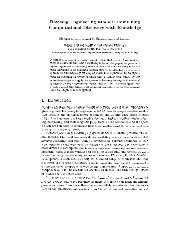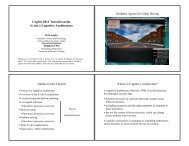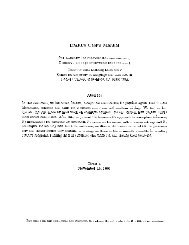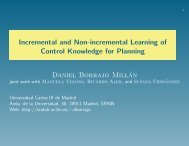Hierarchical Skills and Cognitive Architectures - Computational ...
Hierarchical Skills and Cognitive Architectures - Computational ...
Hierarchical Skills and Cognitive Architectures - Computational ...
Create successful ePaper yourself
Turn your PDF publications into a flip-book with our unique Google optimized e-Paper software.
Table 1: Icarus skills for multi-column subtraction.<br />
(subtract ()<br />
:percepts ((digit ?digit))<br />
:requires ((top-row ?digit) (right-col ?digit))<br />
:unordered ((process ?digit))<br />
(subtract ()<br />
:requires ((processed ?digit1) (top-row ?digit2)<br />
(left-of ?digit2 ?digit1))<br />
:unordered ((process ?digit2))<br />
(process (?digit)<br />
:ordered ((borrow ?digit)<br />
(find-difference ?digit))<br />
:effects ((processed ?digit)))<br />
(borrow (?digit1)<br />
:percepts ((digit ?digit2) (digit ?digit3))<br />
:start<br />
((greater ?digit2 ?digit1)<br />
(nonzero ?digit3))<br />
:requires ((above ?digit1 ?digit2)<br />
(top-row ?digit3)<br />
(left-of ?digit3 ?digit1))<br />
:ordered ((decrement ?digit3)<br />
(add-ten ?digit1))<br />
:effects ((greater ?digit1 ?digit2)))<br />
(borrow (?digit1)<br />
:percepts ((digit ?digit2) (digit ?digit3))<br />
:start<br />
((greater ?digit2 ?digit1)<br />
(zero ?digit3))<br />
:requires ((above ?digit1 ?digit2)<br />
(top-row ?digit3)<br />
(left-of ?digit3 ?digit1))<br />
:ordered ((borrow ?digit3))<br />
:effects ((greater ?digit1 ?digit2)))<br />
(decrement (?digit)<br />
:percepts ((digit ?digit val ?val))<br />
:start ((nonzero ?digit))<br />
:actions ((*cross-out ?digit)<br />
(*decrement ?digit ?val))<br />
:effects ((crossed-out ?digit)))<br />
(add-ten (?digit1)<br />
:percepts ((digit ?digit1 val ?val1)<br />
:start<br />
(digit ?digit2) (digit ?digit3))<br />
((above ?digit1 ?digit2)<br />
(top-row ?digit3)<br />
(left-of ?digit3 ?digit1)<br />
(crossed-out ?digit3))<br />
:actions ((*add-ten ?digit1 ?val1))<br />
:effects ((greater ?digit1 ?digit2)))<br />
(find-difference (?digit1)<br />
:percepts ((digit ?digit1 col ?col val ?val1)<br />
(digit ?digit2 col ?col val ?val2))<br />
:start<br />
((above ?digit1 ?digit2)<br />
(greater-or-equal ?digit1 ?digit2))<br />
:actions ((*add-difference ?col ?val1 ?val2))<br />
:effects ((processed ?digit1)))<br />
ultimately connect to perceptual elements. The literals<br />
that appear in the :start, :requires, <strong>and</strong> :effects<br />
fields must be defined concepts, thus linking the skill <strong>and</strong><br />
conceptual memories in an interleaved manner. The architecture<br />
also incorporates three short-term memories.<br />
These include a perceptual buffer, updated on each cycle,<br />
that contains descriptions of perceived objects, a conceptual<br />
short-term memory that contains inferences derived<br />
from the perceptual buffer, <strong>and</strong> an intention memory<br />
that contains instances of skills the system intends to execute.<br />
The elements in these memories are simple literals<br />
but, because their predicates correspond to hierarchical<br />
structures in long-term memory, they encode substantial<br />
information about the agent’s beliefs <strong>and</strong> intentions.<br />
Distinctive Aspects of Icarus Hierarchies<br />
From the preceding discussion, it should be clear that<br />
Icarus utilizes a more structured representation of<br />
knowledge than traditional cognitive architectures, but<br />
the implications of this structure depend directly on the<br />
processes that operate over them. Together, they enable<br />
cognitive processing that exhibits important differences<br />
from that in older frameworks.<br />
One such characteristic involves the ability of Icarus’<br />
skills to reference subskills by their names, rather than<br />
through the indirect references used in Soar, ACT, <strong>and</strong><br />
Prodigy. For example, the borrow skill in Table 1 calls<br />
directly on decrement <strong>and</strong> add-ten. Icarus’ approach<br />
has some aspects of subroutine calls in procedural programming<br />
languages but, when combined with multiple<br />
expansions for each skill (such as two variants for borrow),<br />
effectively embeds these calls within an AND/OR<br />
search. This makes our formalism a close relative of<br />
logic programming languages like Prolog, which uses a<br />
very similar syntax to support logical reasoning. But like<br />
other cognitive architectures, Icarus is concerned with<br />
agents that exist over time, so it situates these computations<br />
within a recognize-act cycle.<br />
As a result, Icarus retains the overall flavor of a production<br />
system but gains the ability to invoke subskills<br />
directly, rather than through the creation of short-term<br />
memory elements. This lets it execute complex skills in<br />
a top-down manner without having to descend through<br />
the hierarchy one step at a time. Icarus can take advantage<br />
of this hierarchical organization without requiring<br />
the generation of explicit intermediate goal structures<br />
that are needed by production systems.<br />
Recall that Icarus includes a short-term memory that<br />
contains skill instances the agent considers worth executing.<br />
On each cycle, for each skill instance, the architecture<br />
retrieves all decompositions of the general skill <strong>and</strong><br />
checks whether they are applicable. A skill is applicable<br />
if, for its current variable bindings, its:effects field<br />
does not match, the :requires field matches, <strong>and</strong>, if the<br />
system has not yet started executing it, the :start field<br />
matches the current situation. Moreover, at least one of<br />
its subskills must also be applicable. Since this test is<br />
recursive, a skill is only applicable if there exists at least<br />
one acceptable path downward to executable actions.<br />
For each such path, the architecture computes the expected<br />
value <strong>and</strong> selects the c<strong>and</strong>idate with the highest<br />
utility for execution. For a given path, it uses the value<br />
function stored with each skill <strong>and</strong> the numeric values<br />
matched in that skill’s :percepts field to calculate the<br />
expected value at each level, summing the results along<br />
the path to compute the overall score. For instance, for<br />
the path ((subtract), (process digit11), (borrow digit11),<br />
(decrement digit21)), the system would sum the expected<br />
value for all four levels to determine the utility<br />
of decrementing. This means that the same action can







